Cat Body Language: Talk To The Paw
Cat body language is somewhat limited. That's according to Gwen Bailey, a leading animal behaviorist and author. Non-verbal cat talk is also sometimes difficult for humans to interpret.
In What is my cat thinking?, animal behaviorist Gwen Bailey lays out many of the common feline behaviors and what they mean. In writing the book, she stands up for the rights of domestic cats and hopes that people will gain a greater understanding of the needs of their feline companions.
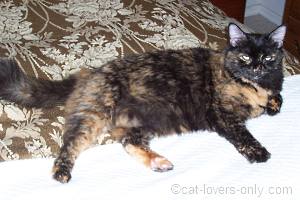 Back legs extended and belly exposed to the side, Frankie displays a relaxed pose.
Back legs extended and belly exposed to the side, Frankie displays a relaxed pose.Cats communicate how they feel, what they want, and what their intentions are in a number of different ways, both verbally and non-verbally.
Some are subtle, like a barely audible purr or a slight head tilt, and some are not so subtle, like a firm meow or a loud hiss.
We can't always know for certain how to interpret what our cats are trying to say with their bodies, or even with their meows. To the observer in the know, however, interpreting a combination of cat body language, behavior, and verbal queues can often tell a story of how a cat is feeling.
According to Gwen Bailey, there aren't many scientific studies on domestic cat body language, so we rely on experience and observations by experts, combined with what we ourselves observe.
We're all familiar with the flick of the tail, the pinning back of the ears, the arch of the back, and the showing of teeth. These are very recognizable and universally feline expressions. As cat owners, we also become accustomed to the unique ways in which each cat uniquely expresses various states of pleasure, need, contentment, hunger, and so on.
A better understanding of cat body language can assist in training your cat. Cats can be trained to display many useful behaviors and come when called, sit, stay, open doors, and perform tricks.
Below are some descriptions of feline body language and actions.
- Tails - In addition to being used for balance (or to smack you upside the head), the tail is an expressive appendage, and very versatile.
The tail up greeting, the vertical "I'm happy and confident" tail, the the "I'm worried" tail between the legs are all familiar cat postures.
Cats who feel threatened may crouch, flatten ears, and tuck in tails to both make their target area smaller, and protect their ears and tails from attack.
In other cases, the ears are flattened and the tail tucked for protection, but the cat puffs up with hairs sticking straight out. They often then turn their bodies sideways in order to appear larger and menacing. - Cheek Rubbing - Cats will rub strategic areas with their cheeks (and various other parts of their body) in order to spread their scent around, making them feel more secure. They'll also rub their scent on family members to create a communal scent.
- Threats, Spraying and Scratching - Cats who feel insecure about their territory may spray inside the house. Depositing more of their scent makes them feel more secure.
They may spray when feeling threatened by scents brought into the home on shoes or clothing, by outside cats, or by a dominant cat in the house. Even changing the furniture can sometimes cause this behavior.
Scratching not only removes the outer sheath of the claws, it allows the cat to release scent as well as relieve stress.
Punishing a cat for doing what comes naturally rarely ends in the result the cat parent wants, and usually makes things worse.
Instead, having your cat spayed or neutered can help reduce spraying, as can making sure your cat has a relaxed environment to live in.
Providing appropriate scratching surfaces, such as this PetFusion Ultimate model can help take care of your kitty's need to scratch, and Feliway may help calm your cat. - Cats and Dogs - While dogs have tails and walk on all fours, they have very different body language from cats. Cats and dogs can get along, but it takes them a while to get used to confusing signals.
Many cats will swish their tails back and forth when they're agitated. You may also see them do this when they're staring (sometimes looking out the window) at potential prey.
Dogs, in contrast, usually wag their tails when they're happy. It can be a confusing conversation for each animal. - Friend or Foe - Cats, when confronted with new people or other animals, will evaluate the situation and try to determine if the newcomer is a friend or foe. They may initially run away, or approach cautiously or indirectly.
- Don't stare me down - You may have seen two cats facing off and staring at each other. There's all kinds of posturing and sometimes, hissing, spitting, or even howling.
More often than not, it's probably two tom cats fighting over territory. The stare is a challenge, and many cats don't like it when you look them directly in the eye for an extended period.
Even staring at a cat who trusts you may be disconcerting, and the cat may move on to a less threatening situation. The "polite" thing to do, in terms of cat body language, is to briefly look, slow blink once or twice, and look away. - Sitting on strangers - It's a common situation. You have several people come over to visit, and your most gregarious cat wants to see who the strangers are.
Your cat assesses the motley crew you've assembled, and decides to sit in the lap of one of the strangers. This is often the one person in the room who doesn't like cats.
People often wonder why cats will often sit on the lap of people who seem to like them least. The answer is that often, those who like cats will come at them, lean into them, make noises, and stare at them. This is threatening and makes the cat feel uncomfortable.
The person who doesn't like cats usually appears the least interested, and therefore least threatening. They often don't pay much attention to the cat, until the cat appears in his or her lap! - You can't make me like you - Chasing after a cat, or picking a cat up and trying to snuggle with them is likely to not endear you with her.
Cats have to like you, and take affection from you, on their own terms. Even the most sociable of cats likes to have some alone time, and you may have to wait for the timing to be right. Hint: Food, toys, and treats can help. - Stroking - Stroking your cat brings her back to kitten-like behaviors, including kneading or treading with the paws, and purring.
Kneading is what a kitten does to its mother in order to stimulate milk production, and purring is the universal feel-good cat response.
Some cats may become too excited or defensive and use teeth or claws if you stroke the wrong area or touch them for too long. "Safe" stroking areas typically include the head, the back (but perhaps not near the tail), the sides, and sometimes the tail itself.
Stroking or scratching the back at the base of the tail will allow a cat to spread some scent on you. Many cats seem to appreciate this, but with unfamiliar cats, you might want to avoid the tail area at first. Some cats have had their tails pulled and may get defensive if you go for the tail.
A cat will naturally protect its head, neck, underbelly, and legs, and may not like strangers touching them there at first. When meeting new cats, it's sometimes best to start with the "safe" areas and see if the cat offers a head butt.
If the cat offers the belly area, it's a sign of great trust. Touching this sensitive area may still invoke a negative reaction, though, indicating it's time to stop stroking. - Cat fights - Real cat fights among adult domestic cat are relatively rare and usually end quickly. Aggression is typically the action of last resort, as serious injury or death may occur in a cat fight.
Much of a cat's aggressive body language is designed to avoid fights, rather than start or invite them. Cats use a variety of body postures, movements, and noises (growling, hissing) to signal warnings to other cats to not come any closer.
When this fails, a cat may have no choice but to fight. It's very important for the cat who wants to back down to do so carefully and slowly, or the aggressor may attack. - Hiding - Cats hide for obvious reasons. In the wild, the ancestors and modern day counterparts of the domestic cat use hiding behavior to protect themselves.
Until a threat is assessed, a cat is cautious. Some cats are bolder than others, and will confront challengers. Others hide as a first response, sometimes coming out after a period to test things out and do a threat assessment. - Vet anxiety - If your cat is in a threatening situation, but in an area where she can't run and hide (like in the vet's office), holding her securely in your arms and/or lap may make her feel more secure.
To give her the most secure feeling she can have, let her bury her head under your arm to hide her eyes until the vet or the vet tech can take her.
You can also bring a blanket, preferably with familiar scents on it (yours and your kitty's), that she can hide under. In these situations she may prefer to remain (and not come out of) her carrier.
It's amazing how much strength, power, and determination is wrapped up in a 12 pound body. From experience I can tell you that getting one of the cat carriers that easily opens completely, or has access from the top will save you much grief, and possibly some scratch wounds.
It's also less stressful on your cat if you can just reach in and scoop her out of the carrier. I bought this top loading carrier for Jazzy, and it's so much easier than a strictly front loading carrier. - Play and Hunting - Play and hunting are inexorably linked in cats. As kittens, the instinct to chase, fight, and hunt is expressed in play activities with siblings and the mother cat.
In the wild, a mother cat will teach hunting skills by example, and teach her kittens to associate hunting and killing with eating.
The desire to hunt/play will continue throughout most of the cat's life, and gradually decline with age as the cat becomes less active. Although older cats can often be as playful as kittens, they usually tire of the game sooner.
Regular play has many benefits to the domestic cat, even seniors. It provides healthy exercise, and satisfies the deeply ingrained "inner hunter" of today's well fed, lap of luxury cats.
If your cat is getting a bit pudgy, increasing exercise levels through play is vital in order to prevent health problems like feline diabetes, arthritis, and heart problems due to obesity.
Playtime Tip: If your cat has gotten out of the play habit, follow these tips to stimulate her interest:
- Cats are interested in motion. Dragging something as simple as a leather belt across the floor can stimulate your cat's play response.
- Allow your cat to "catch and kill" a few times in each play session. Chasing and pouncing is fun, but may be frustrating if the kill is never experienced.
- Rotate cat toys out. If your cat brings a toy to her sleeping spot, then that's probably a favorite, so leave that one out. For the rest of them, hide them away and bring out a few at a time on a rotating schedule. Refresh them with a little catnip, and the toys will seem new again.
- Something as simple as movement under a bed sheet can be fascinating to your cat (but rough on the sheets, so use an old one). Hiding toys just out of sight or having them make movements in and out of sight can stimulate play.
Domestic cats may sometimes walk with their tails up, while wild cats will lower them as they stroll along, sometimes keeping them between their legs. A straight up tail, sometimes quivering with excitement, means "I'm happy to see you," while a curl on the end means "I'm top cat."
Cat Body Language Examples
Below, we show Teddie in some various pictures, also with Frankie and Priscilla, to illustrate some examples of the body language used by the domestic cat.
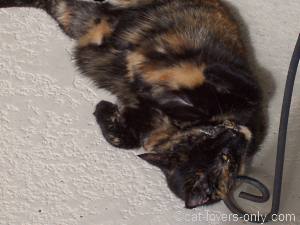
In this photo, Teddie has fun on the patio and exposes her belly while scenting the leg of a planter with her cheek.
She's scenting things up to claim ownership, and at the same time, showing me her belly in submission.
For a cat, the exposed belly is the ultimate sign of trust.
Some cats will be willing to expose it, but recoil and have a scratching or biting response when it's touched. Don't take it personally, it's just a cat thing!
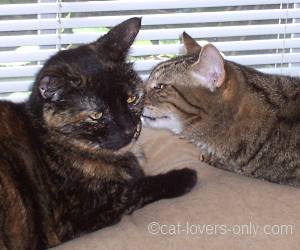
Priscilla (R) checks Teddie with a sniff as they relax and bird watch by the window.
Cats have amazing noses, and by taking in another cat's scent, they can tell where the other cat has been, and how they're doing.
Face to face encounters like this require a great deal of trust.
Nose to nose in this way, either cat is vulnerable to serious injury by the other should one of them attack.
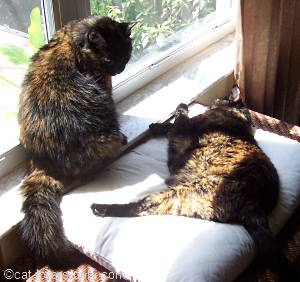
Teddie (R) shows with her body language that she's totally relaxed and literally open, exposing the vital belly area, even though her sister, Frankie looms over her.
Teddie wouldn't be so nonchalant around a cat she didn't trust, but here, she doesn't seem to be at all interested in what Frankie is up to.
I believe Frankie was actually hunting a bug of some kind, but her sister was not impressed.
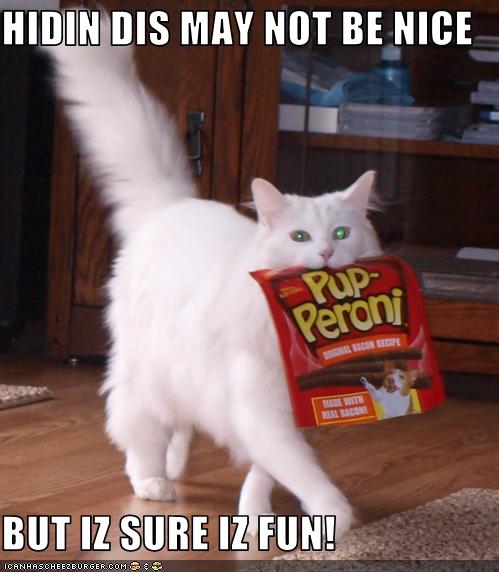


Comments: What do you think?
Have your say about what you just read. Leave me a comment in the box below.